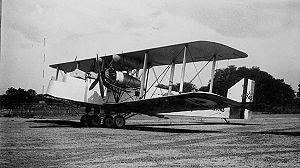Top speed 198 km/h Length 18 m First flight March 26, 1927 | Wingspan 23 m Introduced 1929 | |
 | ||
The Handley Page Hinaidi was one of two twin-engine bombers built by Handley Page that served with the Royal Air Force between 1925 and 1935. The aircraft was developed from the Handley Page Hyderabad and named after Hinaidi, an RAF station in Iraq.
Contents
Design and development
In 1923, Handley Page designed and built a new heavy bomber based on its W.8 airliner, the Hyderabad. The Hyderabad was an all-wooden biplane powered by two Napier Lion engines. Forty-five were built, entering service from 1925.
The Hinaidi was an improved version of the Hyderabad built to meet Air Ministry Specification 13/29. The first machine, the HP33 Hinaidi I -in fact an early production Hyderabad, J7745, with another engine and a change of fin and rudder- first flew on 26 March 1927. At least four Hyderabads were converted to Hinaidi Is, while six late-production Hyderabads were completed as Hinaidi Is, retaining the wooden airframe of the Hyderabads. The first true Hinaidi, the HP36 Hinaidi II, went into production after major structural modifications were implemented, the structure being changed from wooden to metal.
A re-engined version with two 480 hp Siddeley Jaguars was proposed, the HP44 Hinaidi III, but not built.
Operational history
The first 33 aircraft came into service in 1929, and were issued to No. 99, No. 10 and No. 503 squadrons. Total production ended with 36 aircraft, with some being converted to transport aircraft on the North-West Frontier in India. The Clive II transport version operated out of Lahore.
Variants
Operators
Specifications (Hinaidi Mk II)
Data from Aircraft of the Royal Air Force
General characteristics
Performance
Armament
